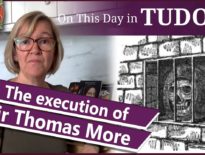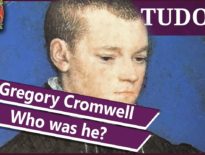On this day in Tudor history, 5th July 1535, Henry VIII’s former Lord Chancellor and good friend, Sir Thomas More, wrote his final letter.
More's last letter was addressed to his beloved daughter Margaret (Meg) Roper and it was written in coal. It is a touching letter and includes instructions and messages for other members of the family.
In today's talk, I share Sir Thomas More's letter and give details on the people mentioned, along with explaining the meaning of the algorism stone.
Also on this day in Tudor history, 5th July 1589, three Essex women were hanged at Chelmsford, Essex, after being found guilty of murder by witchcraft. Find out how these women came to be accused of witchcraft and why they were hanged in last year’s video:
Also on this day in history:
- 1583 – Execution of John Copping, shoemaker and religious radical, for 'dispersing' books by Robert Browne and Richard Harrison, which were viewed as “sundry seditious, schismatical and erroneous printed books”. Copping had been arrested with his friend Elias Thacker, a tailor, and Thacker was executed the day before. Books were burned at each of their executions.
- 1589 – Executions of Catholic priests and martyrs George Nichols and Richard Yaxley, along with Catholics Thomas Belson and Humphrey Prichard. Nichols and Yaxley were hanged, drawn and quartered, and Belson and Prichard were hanged.
- 1591 – Burial of Humfrey (Humfray) Cole, goldsmith, engraver, mathematical instrument maker and die sinker, at St Gregory by St Paul's, London. Cole was a die sinker at the Tower of London mint. His mathematical instruments included an armillary sphere, astrolabe and instruments needed for Martin Frobisher's 1576 voyage. Twenty-six of his instruments still survive today.
- 1600 – Execution of Jean Livingston (Lady Warriston) at the Girth Cross in Edinburgh. She was beheaded by the 'Maiden', a type of guillotine, for murder. Livingston was unhappily married to John Kincaid of Warriston when her nurse, Janet Murdo, came up with the idea of murdering him to release Livingston from her torment. Livingston asked a servant, Robert Weir, to do the deed, which he did on the night of 1st July 1600. Murdo was burned at the stake on Castle Hill and Weir, who had fled after the murder, was arrested in 1604 and 'broken on the wheel' at Edinburgh.
Transcript:
On this day in Tudor history, 5th July 1535, Henry VIII’s former Lord Chancellor and good friend, Sir Thomas More, wrote his final letter.
More was imprisoned in the Tower of London at the time. He’d been sent there in April 1534 after refusing to swear the oath of allegiance to the Act of Succession. He explained to his daughter, Margaret Roper, that although he “would not deny to swear to the succession”, he could not sweat the oath offered to him without “the jeoparding” of his soul “to perpetual damnation”. His refusal was seen as an act of treason and he was imprisoned for it.
During his time in the Tower, he spent time in contemplation and prayers, and wrote prayers, letters and treatises. In the meantime, members of the king’s council tried to persuade him to submit to the king, but his conscience just wouldn’t allow him to. He was tried for high treason on 1st July 1535 and pleaded not guilty to all of the charges laid against him, but he was found guilty and sentenced to a full traitor’s death, although it was commuted to beheading by axe.
On this day in 1535, the day before his execution, he wrote a final letter, addressing it to his beloved daughter, Margaret, or Meg, Roper. It was written with coal on pieces of paper that he “could obtain by stealth”. Here is what he wrote:
“My good daughter,
Our Lord bless you good daughter and your good husband and your little boy and all yours and all my children and all my godchildren and all our friends. Recommend me when you may to my good daughter Cecilye, whom I beseech our Lord to comfort, and I send her my blessing and to all her children and pray her to pray for me. I send her an handekercher and God comfort my good son her husband. My good daughter Daunce hath the picture in parchment that you delivered me from my Lady Coniers; her name is on the back side. Show her that I heartily pray her that you may send it in my name again for a token from me to pray for me.
I like special well Dorothy Coly, I pray you be good unto her. I would wit whether this be she that you wrote me of. If not I pray you be good to the other as you may in her affliction and to my good daughter Joan Aleyn to give her I pray you some kind answer, for she sued hither to me this day to pray you be good to her.
I cumber you good Margaret much, but I would be sorry, if it should be any longer than tomorrow, for it is Saint Thomas even, and the utas [vigil] of Saint Peter and therefore tomorrow long I to go to God, it were a day very meet and convenient for me. I never liked your manner toward me better than when you kissed me last for I love when daughterly love and dear charity hath no leisure to look to worldly courtesy.
Fare well my dear child and pray for me, and I shall for you and all your friends that we may merrily meet in heaven. I thank you for your great cost.
I send now unto my good daughter Clement her algorism stone and I send her and my good son and all hers God’s blessing and mine.
I pray you at time convenient recommend me to my good son John More. I liked well his natural fashion. Our Lord bless him and his good wife my loving daughter, to whom I pray him be good, as he hath great cause, and that if the land of mine come to his hand, he break not my will concerning his sister Daunce. And our Lord bless Thomas and Austen and all that they shall have.”
In the book “Last Letters”, in his essay on More’s last letter, Terence McCarthy notes that for More “the things that were now important had no earthly prestige. Not kings, but handkerchiefs, algorism stones and pictures in parchment” and that these things might seem an object of trifling insignificance, but they were important to More.
I was interested in the names he mentions in this last letter.
Meg, who the letter was addressed to, was More eldest child and one of four children he had with his first wife Joan, Jane or Joanna Colt. She was born in 1505 and had married William Roper in 1521. She was a learned woman who was incredibly close to her father, and, after his execution, she retrieved his head from a pike on London Bridge for a proper burial.
Cecily was his third daughter by Joanna. She was born in 1507 and had married Giles Heron in 1525.
More’s good daughter Daunce was his second daughter, Elizabeth, who was born in 1506 and who had married William Daunce in 1525.
Dorothy Coly was Meg’s maid and was married to More’s secretary John Harris.
In “The Last Letters of Thomas More”, editor Alvaro de Silva explains that Joan Aleyn was “another maid who likely grew up with Margaret and her sisters and attended the school that More ran at home in Chelsea.”
John More was More’s only son and heir. He was born in 1509 and had married Anne Cressacre in 1529.
Thomas and Austen were John More’s eldest children, born in 1531 and 1533. Thomas would live to 1606 but Austen died as a child.
And the “good daughter Clement” was Margaret Clement, who was adopted by More as a companion for his daughter, Meg, after he spotted her intelligence and piety. More had her educated with his daughters. She married physician John Clement, who taught her Greek while she was in More’s household. She was close to her adoptive father and was the only member of More’s household who witnessed his beheading.
More’s second wife, Alice, who he’d married in 1511, within a month of the death of his first wife, is not mentioned in the letter, but Terence McCarthy states that we shouldn’t read too much into this for there may have been no need for him to mention her if she was with him while he was writing it or he had had chance to say his goodbyes to her. Seymour Baker House notes that More had once written that “he could not tell which was dearer to him, the wife who bore their children or the wife who raised them, although privately he intimated that his second wife was less intellectually capable”, so it would be unfair to surmise that Alice is not mentioned because he didn’t love her.
And what about the algorism stone that More wants sent to Margaret Clement – what is that? Well, in his book “Sir Thomas More: His Life and Times”, William Joseph Walter explains that “an algorism stone was a device for learning arithmetic, something in the nature of the multiplication table”. More was an intelligent man and would have had no need to learn arithmetic, but perhaps he used it for mathematical puzzles to keep his mind active while he was in the Tower, and now wanted his adopted daughter to have it as a keepsake.
I was interested to learn that following More’s death, Margaret Clement ministered to the Carthusian monks who had been imprisoned in Newgate after also refusing to sign the oath. They were chained to posts and Margaret bribed their gaoler so that they could be given food and kept clean. Unfortunately, the king found out about it and put a stop to it and the monks died of starvation. She did her best to save them, or at the very least to make their final days more comfortable.



Leave a Reply